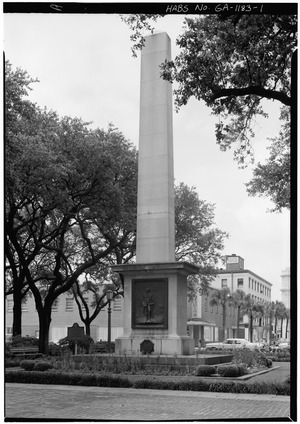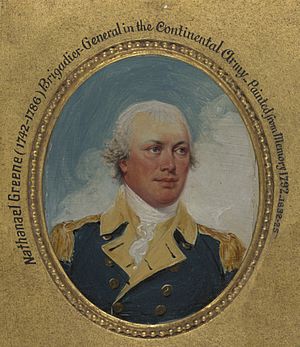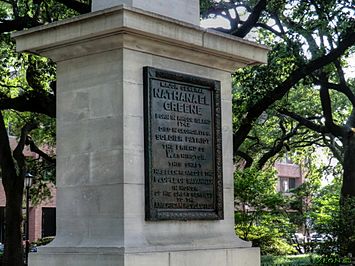Nathanael Greene Monument facts for kids

Historic American Buildings Survey picture of the monument
|
|
| Lua error in Module:Location_map at line 420: attempt to index field 'wikibase' (a nil value). | |
| Location | Johnson Square, Savannah, Georgia, United States |
|---|---|
| Designer | William Strickland |
| Material | Granite |
| Height | 50 feet (15 m) |
| Beginning date | March 21, 1825 |
| Completion date | 1830 |
| Dedicated to | Nathanael Greene |
The Nathanael Greene Monument is a special public monument in Savannah, Georgia. It stands in Johnson Square. This monument honors Nathanael Greene, a brave general from the American Revolutionary War.
The monument was designed by William Strickland. Its first stone was placed in 1825. It was finished in 1830. At first, it honored both General Greene and another general, Casimir Pulaski. By 1853, it became a monument just for Greene. Two bronze plaques were added to it later. In 1902, Greene's body was buried beneath the monument. In 2018, one of the plaques was changed in a funny way with googly eyes. This made the monument famous across the country!
This monument is one of many in Savannah. Other monuments honor important people from the American Revolution. These include the Casimir Pulaski Monument and the William Jasper Monument.
Contents
Discovering the Monument's Past
Who Was Nathanael Greene?
Nathanael Greene was born in Rhode Island in 1742. He grew up in a peaceful Quaker family. But as the American Revolution began, he helped start a local army. He quickly became a brigadier general in the Continental Army.
During the war, Greene fought in the southern colonies, including Georgia. For his brave actions, the Georgia government gave him a large farm. It was called Mulberry Grove Plantation. In 1786, Greene County, Georgia was named after him. He passed away later that year at Mulberry Grove. He was first buried in Colonial Park Cemetery in Savannah.
Laying the First Stone
On March 21, 1825, a famous French general visited the United States. This was Gilbert du Motier, Marquis de Lafayette. He helped lay the first stones for two monuments in Savannah. One was for Greene in Johnson Square. The other was for General Pulaski in Chippewa Square.
At the ceremony for Greene's monument, Lafayette spoke. He said Greene was a great and good man. He praised Greene's courage and leadership during the war.
Building the Monument
It was hard to raise money for the monuments at first. In 1826, the Georgia General Assembly allowed a special lottery. This was to help collect $35,000 for the project. Because of the money problems, they decided to build just one monument. It would be in Johnson Square and honor both Greene and Pulaski.
The monument was finished in 1830. William Strickland designed it. In 1853, enough money was finally raised for Pulaski's own monument. It was built in Monterey Square. After this, the Johnson Square monument became dedicated only to Greene.
Around 1860, before the American Civil War, the monument saw some celebrations. People celebrating Georgia leaving the United States gathered there. They hung a large flag on the monument. It had a rattlesnake and the words "Don't Tread on Me."
Adding Plaques and Reburial
In 1879, Savannah's city council and the Georgia Historical Society worked together. They planned to "finish" the monument. They decided to add two bronze plaques. The city and the historical society shared the cost.
These plaques were shown in a ceremony on May 6, 1885. One plaque told about Greene's life. The other had a picture of Greene carved into it. Jefferson Davis, a former president, spoke at the event. He praised Greene's service.
For many years, no one was sure where Greene's body was buried. In 1901, his grave was found in Colonial Park Cemetery. On November 14, 1902, his body was moved. It was reburied under the monument. His son, George Washington Greene, was also buried there. It was hard to tell their remains apart. So, they were buried together.
At the ceremony, a bronze wreath was placed on the monument. The Governor of Rhode Island also attended.
Modern Times and a Funny Incident
In 1953, the Georgia Historical Commission put up a Georgia historical marker. It shared facts about Greene and the monument. In 2012, a local garden club raised money. They added a pretty wrought iron fence around the monument.
In October 2018, something funny happened. Someone put googly eyes on the carved picture of Greene. This made the monument famous! News channels like CNN and CBS News reported on it. The police looked into the incident.
Monument Design
The Nathanael Greene Monument is a tall granite pillar. It stands about 50-foot (15 m) high. In 1853, bronze plaques were added to two sides of the pillar. One plaque shows a carved image of Greene. The other plaque has words written on it:
Major General
Nathanael Greene
Born in Rhode Island 1742
Died in Georgia 1786
Soldier Patriot
The Friend Of Washington
This Shaft has been reared by the
People Of Savannah In Honor
Of His Great Services
to the American Revolution
Images for kids
See also
 In Spanish: Monumento a Nathanael Greene para niños
In Spanish: Monumento a Nathanael Greene para niños
- 1830 in art




